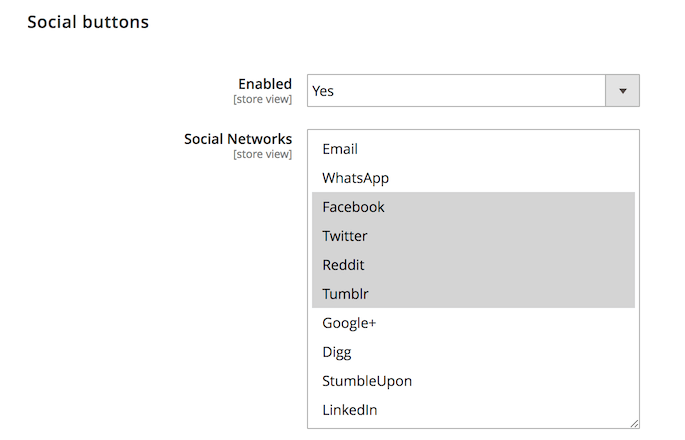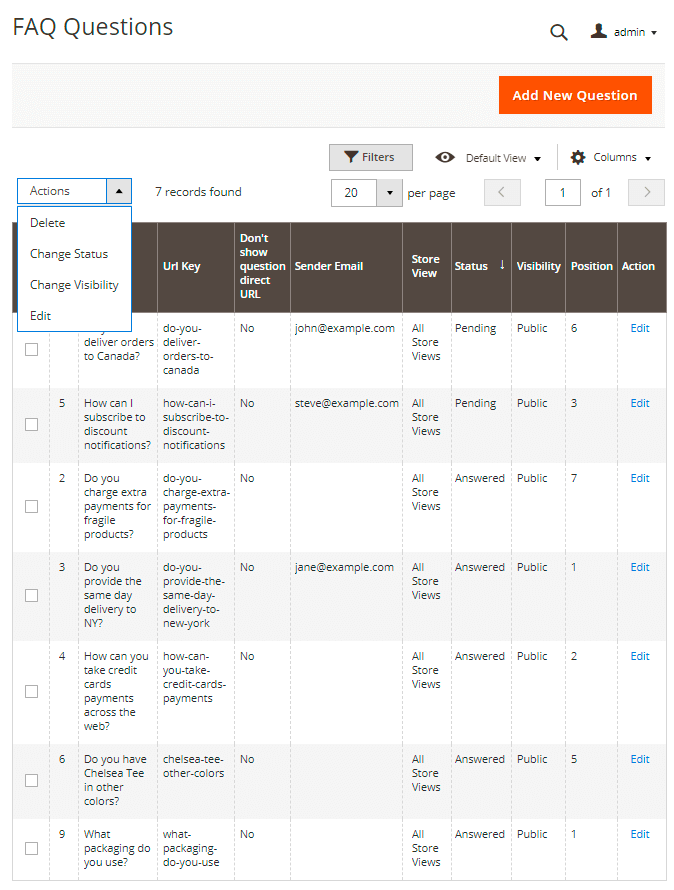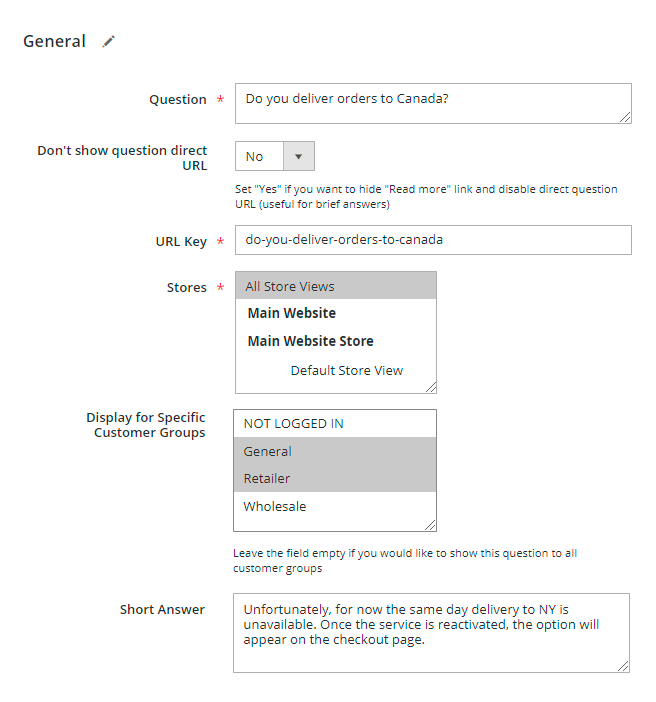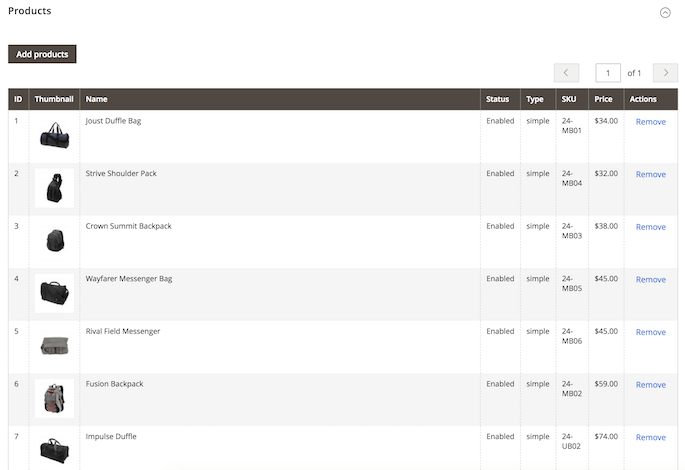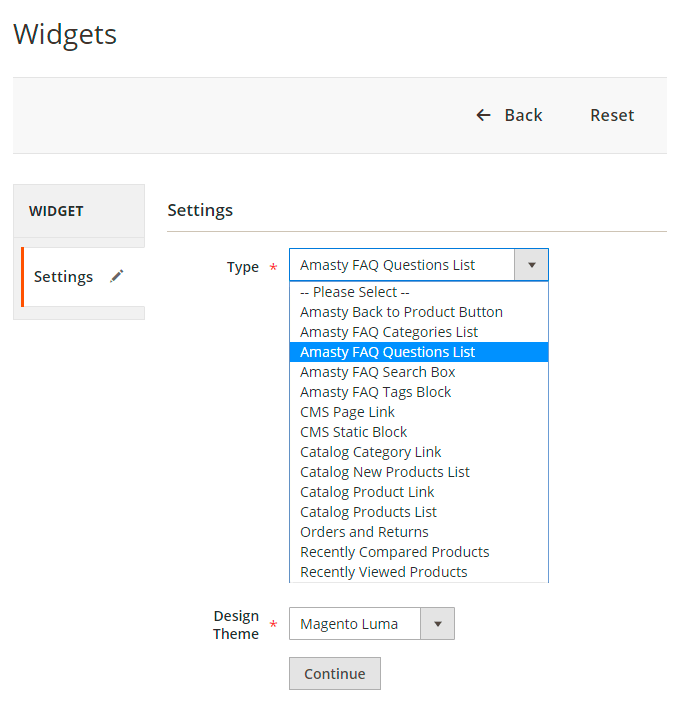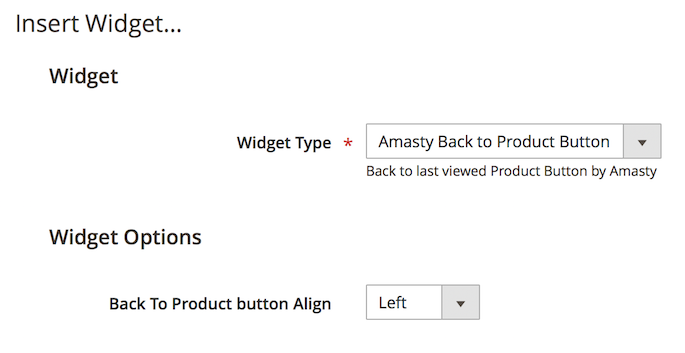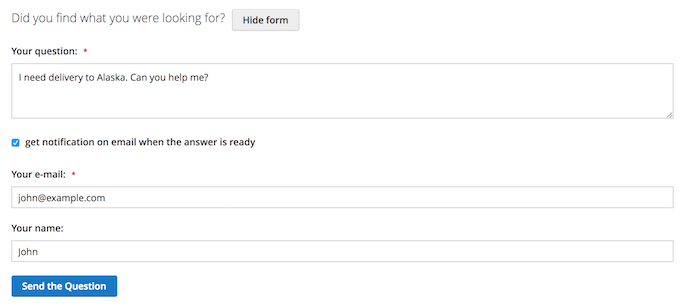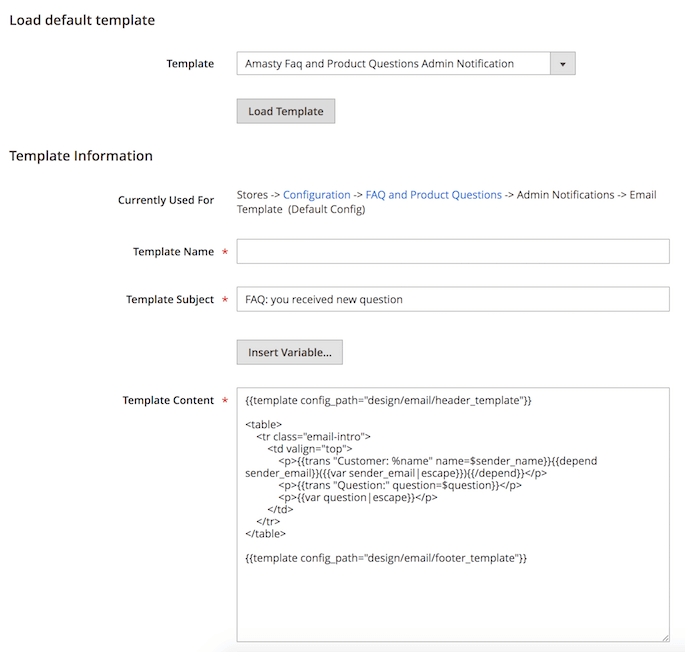User Tools
Site Tools
Sidebar
magento_2:faq_and_product_questions
Table of Contents
For more details see how the FAQ & Product Questions extension works.
Guide for FAQ & Product Questions for Magento 2
With the module, you can add the FAQ section to each product page and provide customers with a comprehensive knowledge base. Advanced SEO features will boost your store's search engine ranking and ensure the supply of user-generated content.
- Separate FAQ section for each product page
- Ability to assign questions to categories and products
- Advanced SEO features to enhance store SERP
- Separate short and full answers to avoid duplicate content
- GDPR compliant and fully optimized for mobile
- Now the extension is GraphQL compatible (read+write)
- Сompliance with WCAG 2.1 level AA requirements (for FAQ with Luma and Hyvä Themes)
- NEW | Compliance with Hyvä Theme Content Security Policies
![]() NEW: Now the module content is available in the German language! Backend and frontend settings are translated according to the selected locale. You can download the sample file with the translated information below:
NEW: Now the module content is available in the German language! Backend and frontend settings are translated according to the selected locale. You can download the sample file with the translated information below:
The extension is compatible with Hyvä Theme. You can find the 'amasty/module-faq-hyva' package for installing in composer suggest.
The compatibility is available as a part of an active product subscription or support subscription.
Extension Configuration
To configure the extension, please go to Stores → Configuration → Amasty Extensions → FAQ and Product Questions. Then, expand the General Settings section.
General Settings
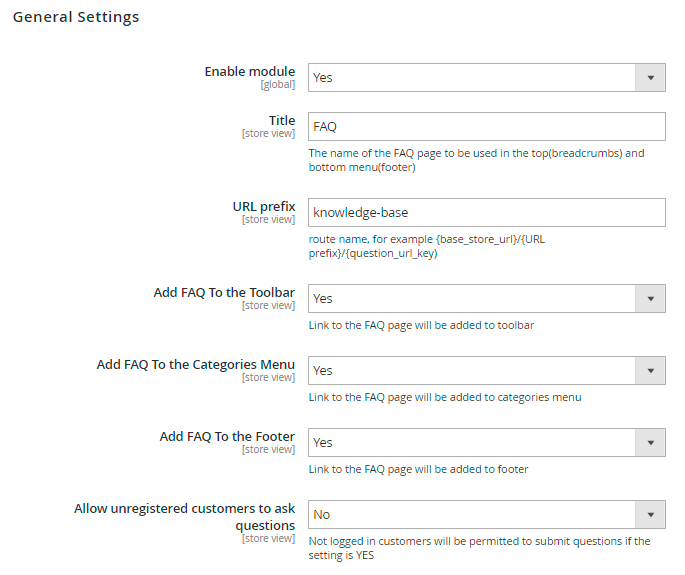
Enable module — enable or disable the extension;
Title — specify the title for the FAQ section;
URL prefix — specify the URL prefix for all the knowledge base pages;
Add FAQ To the Toolbar — enable this option to add the link to FAQ to the toolbar. Please note that Hyvä Theme does not provide this functionality.
Add FAQ To the Categories Menu — enable this option to add the link to FAQ to the categories menu;
Add FAQ To the Footer — enable this option to add the link to FAQ to the footer menu. Please note that Hyvä Theme does not provide this functionality.
Allow unregistered customers to ask questions — enable the option if you want to allow guests to leave questions. If you want only registered customers to leave comments, set the option to No. In this case, unregistered customers will see the notification on the Product Questions tab:
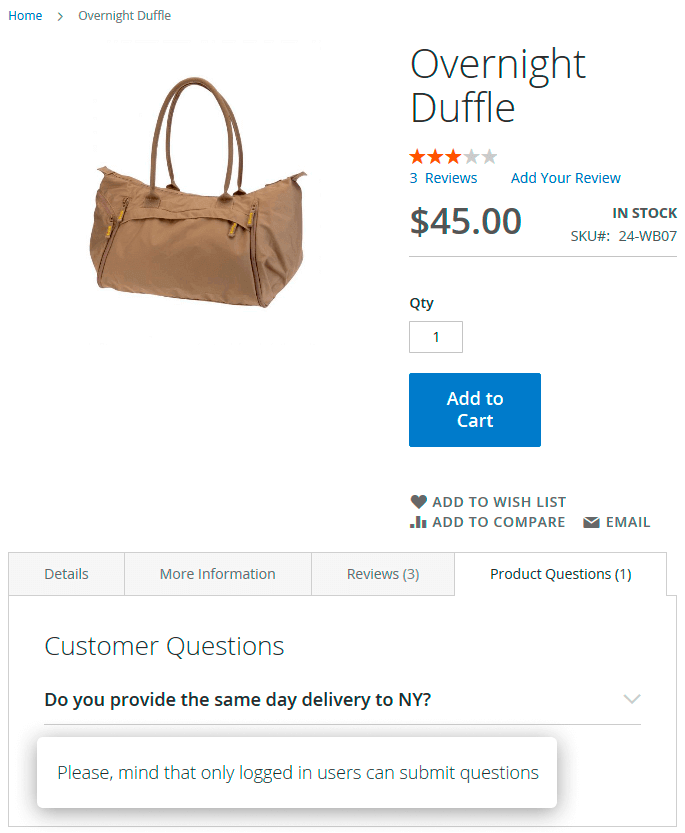
Proceed to the FAQ Home Page section.
FAQ Home Page
Use FAQ Home Page — choose Yes to make a CMS-page as a FAQ home page;
When the Use FAQ Home Page option is set to No, then the list of categories and questions will be displayed.
Select CMS Page — define a CMS-page that will be a FAQ home page. The built-in FAQ Home Page CMS-page will be set by default;
Select FAQ Pages Layout — specify the FAQ pages layout. You can choose to display the sidebar with search and categories on the right or on the left side.
FAQ Search, Navigation and Sorting
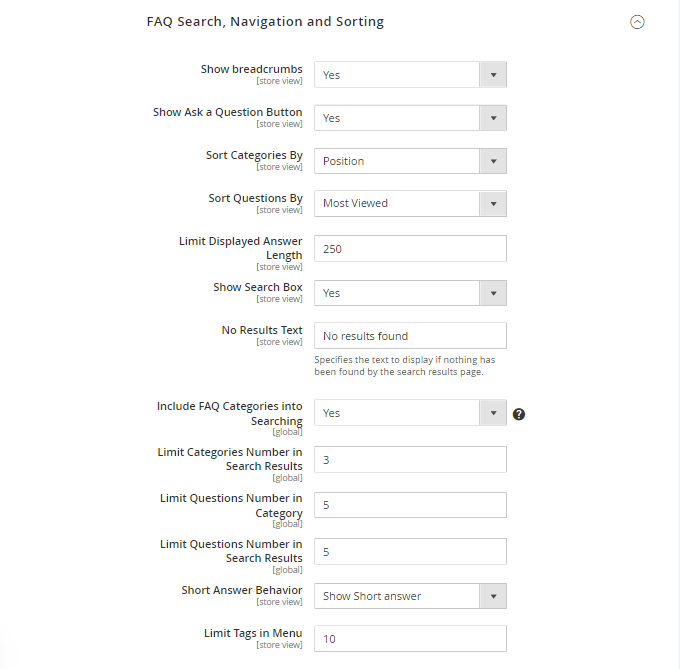
Show breadcrumbs — enable or disable the breadcrumbs display;
Show Ask a Question button — enable or disable the 'Ask a Question' button display. The 'Ask a Question' form will be added to the question and category pages;
Sort Categories By — choose how to sort categories: by position (how to configure), by name, or most viewed;
Sort Questions By — choose how to sort questions: by position (how to configure), by name, or most viewed;
The Most viewed option uses information about questions and categories visits as well as search requests that are gathered from the site visitors.
Limit displayed answer length — specify the number of the full answer symbols to display as preview;
Please notice the following:
- The short answer is displayed on the product pages when it is set. In case the short answer is not set, the full answer will be shortened according to the Limit displayed answer length option;
- On the category pages the full answer will be shortened according to the Limit displayed answer length option and used as a preview;
- When a customer opens the question via a direct URL than the full answer is displayed.
Show Search Box — enable or disable the search box display;
No Results Text — fill in the text to display when no results have been found;
Include FAQ Categories into Searching — enable the setting to get search results based not only on questions but also on categories, provided that the search query matches the category name.
Limit Categories Number in Search Results — set the maximum number of matched categories to be shown with the query in the search results.
Check, how the enabled option will work on the front end:
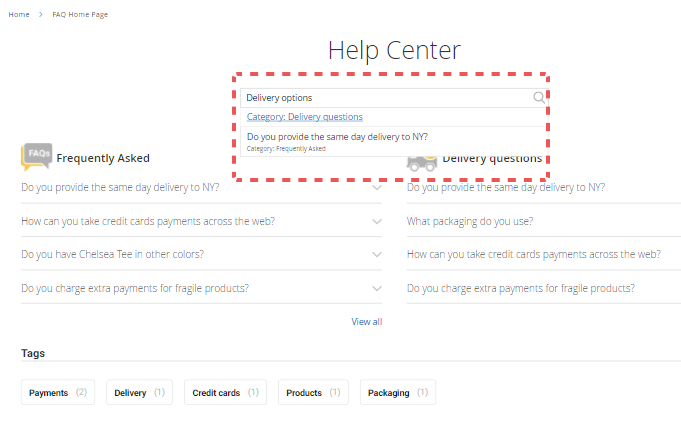
Limit questions number in category — enable pagination on the question category page and display the specified number of questions per page;
Limit questions number in search results — enable pagination on the search results page and display the specified number of questions per page;
Short Answer Behavior — choose to display a Short Answer or a Cut Full Answer. In the second case, the answer will cut using the Limit displayed answer length option's value.
Limit tags in menu — specify the maximal number of tags you want to display in the menu.
User Notifications
Notify user via email — enable this option to notify a user about an answer via email;
When this option is disabled, users won't be able to specify their email when submitting a question.
Email sender — choose the sender of the email notification (how to configure);
Email Template — choose the email template (how to configure).
Please notice that notifications to customers won't be sent automatically. Store admin will have to send them manually using the Save and Send Email to Customer button in the question settings.
Admin Notifications
Notify admin of a new question — enable this option to notify an admin about new questions via email;
Send e-mail to — choose the addressee of the email notification (how to configure);
Email Template — choose the email template (how to configure).
Product Page

Show 'Product Questions' Tab — enable this option to add the 'Product Questions' tab to each product page;
`Product Questions` Tab Name — give a unique name to a `Product Questions` tab. You can use the {count} variable to show how many questions a product has.
`Product Questions` Tab Position — specify the position of a `Product Questions` tab among other product tabs.
This is how the `Product Questions` tab will be displayed on the frontend when the field is provided with the value'3':
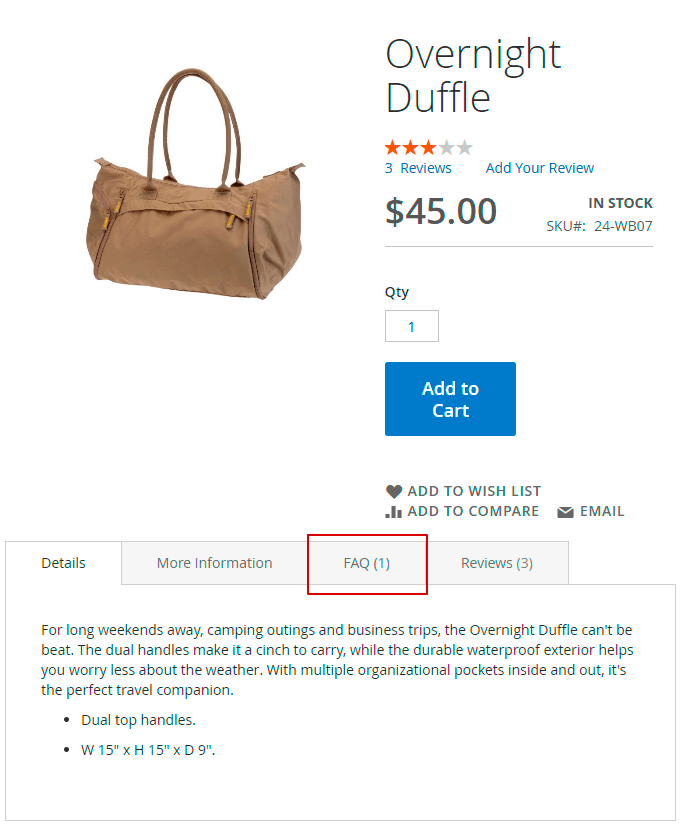
Show Ask a Question button — enable this option to add the 'Ask a Question' button to product pages (this option is available only when the Show 'Product Questions' Tab option is enabled);
Limit questions number — define the number of questions to display on a product page. Please, note that no extra pages will be added, only the specified number of question will be displayed depending on their position;
Short Answer Behavior — choose to display a Short Answer or a Cut Full Answer on product pages. In the second case, the answer will cut using the Limit displayed answer length option's value.
When done, expand the Rating section.
Rating
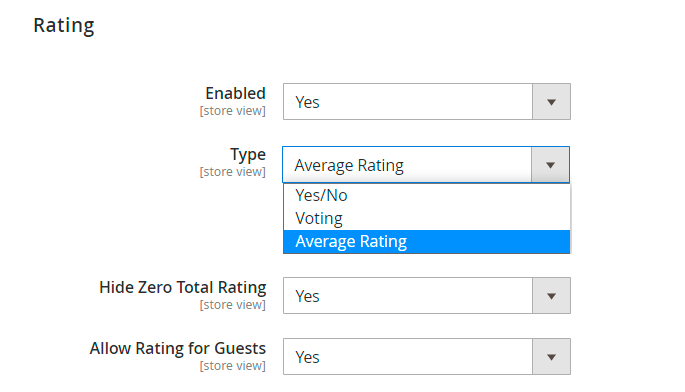
Enabled — choose Yes to enable a rating for each question;
Type — define the rating type: Yes/No, Voting or Average Rating.
Yes/No and Voting samples:
Average Rating sample:

You can customize the average rating from the Edit Question page.
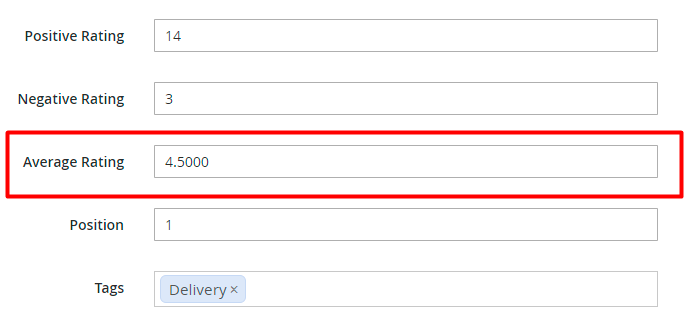
For the Average Rating type, you can also enable the Hide Zero Total Rating option.
Allow Rating for Guests - set to Yes to allow guest users to rate the questions (the option is available for all rating types).
Next, proceed to the Social buttons section.
Social buttons
Enabled — choose Yes to enable social sharing buttons for each question;
Social Networks — define the list of the available social buttons.
SEO
Finally, navigate to the SEO settings.

Enable Question and Category URL Suffix - use this option to generate SEO-friendly URLs for categories and question pages in case you use a standard URL type (e.g. ending with html).
Please mind that changing this configuration may affect your indexing in Google.
Question and Category URL Suffix - specify the suffix to use to FAQ pages.
Please notice that URL keys of FAQ questions and FAQ categories should not contain suffixes added manually earlier.
If the Enable Question and Category URL Suffix option is disabled, you can remove the trailing slash from question and category URLs. Trailing URLs have an impact on SEO since Google marks such URLs as “non-standard”.

Compare:
With a trailing slash: https://.../do-you-provide-the-same-day-delivery-to-new-york/
Without it: https://.../do-you-provide-the-same-day-delivery-to-new-york
Use Canonical URL on Pages — enable this option to add the Canonical URL field to each question;
Mark Up FAQ with Structured Data - enable this option if you want to mark up the elements of the extension with structured data so that Google can understand the data on the page and display relevant result in search results.
Structured data will be added to product pages, FAQ home page, FAQ question pages and FAQ category pages. The feature also supports the speakable parameter, into which the title of the question is pulled.
Enable Rich Data Breadcrumbs — switch this option to Yes in order to utilize breadcrumbs for rich snippets;
Please, note that this option requires the Show breadcrumbs option to be activated in the FAQ page section.
Enable Rich Data Organization — enable this option to activate rich snippets and specify additional organization information.

The extension adds the rich data markup to the FAQ pages only.
XML Sitemap
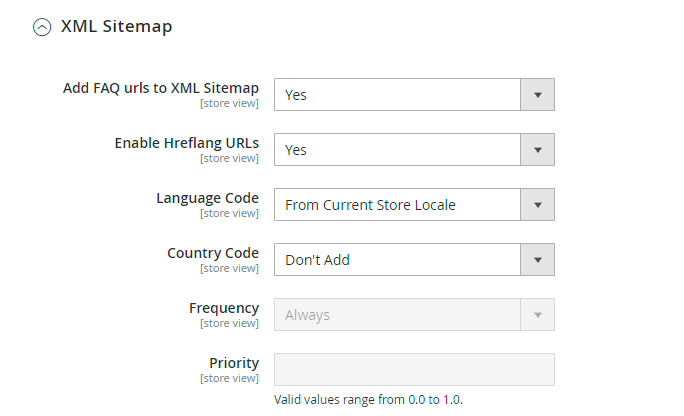
Add FAQ URLs to XML Sitemap — choose Yes to equip the Magento 2 XML sitemap with the links to FAQ pages;
Enable Hreflang URLs - select Yes to notify Google which site and page to show to foreign users. This option is useful for multilingual and multi-regional sites.
Language Code - specify the necessary language code according to the particular store view or choose 'From Current Store Locale'.
Country Code - select the necessary country code (based on a store view). You may also set the code 'From Current Store Default Country' or remove code display by choosing 'Don't Add' option.
Frequency — define the sitemap update frequency (by default, this option utilizes the system value);
Priority — define the sitemap update priority (by default, this option utilizes the system value);
GDPR Consent
To configure GDPR Consent settings, expand the corresponding section.
The extension stores customers' personal data: name and email. This information is used to send notifications about new answers and provide an admin with the ability to reply to users' questions directly via email.
Enable GDPR — choose Yes to add a toggle to the 'Ask a Question' form with the consent to the personal data processing;
Consent Text — use the default one or fill in your own request for personal data processing that will be displayed under the 'Ask a Question' form. This is an HTML field, so you can specify a text and add a link to your privacy policy.
The extension doesn't contain the Privacy Policy page. You can create your own in the Content → Pages section of the admin panel. Adjust a separate CMS-page and add a link to it to the Consent Text field.
GraphQL compatability
With GraphQL you can get precise and multiple data in one query, as well as, modify data using mutation queries. Please, find a few examples* below.
Queries:
- getAmFaqSettings {…} - to configure FAQ module
- searchAmFaqCategories (filter: {…}, sort: {…}, pageSize, currentPage) {…} - to search categories
- searchAmFaqQuestions(search, filter: {…}, sort: {…}, pageSize, currentPage - to search questions
Mutation:
- placeAmFaqQuestion (input: {…}) - to place a question from a current customer or guest (if enabled in configuration)
- ateAmFaqQuestion (input: {…}) - to rate a question
*Full list of queries will be available with documentation upon purchase.
Questions and Answers
To create a new question, edit the existing ones, or add an answer, please go to Content → FAQ Question.
On the grid, you can see all the existing questions.
You can use the Inline edit functionality to instantly modify question's information. Moreover, you can select multiple questions and apply the required mass actions (edit, delete, change status, or visibility).
In the Position column you can adjust the sort order for questions display on the frontend.
To add a new question, please click the Add New Question button or select one of the existing questions to edit it.
The question's configuration menu consists of five sections. Let's take a closer look.
General
Question — fill in the question in this field or edit the existing question, e.g. to correct the misspelled words;
Don't show question direct URL — choose Yes to disable the Read more link and make a question unavailable via direct URL (the URL Key field will become unavailable);
URL Key — specify the URL key for the question here. The key is filled in automatically when the question title is set. However, you can modify the key for SEO purposes;
The URL Key field is mandatory. Also, the field validation is used to prevent URLs from being duplicated within a single store view.
Stores — choose the store views where the question will be displayed;
Display for specific customer groups - here you can limit the display for the specific customer groups;
Short Answer — specify the short answer here. When set, it will be used as a preview of the full answer on the Product Question tab of product pages. Using this functionality you can provide more diverse coverage of the topic and avoid duplicate content issues;
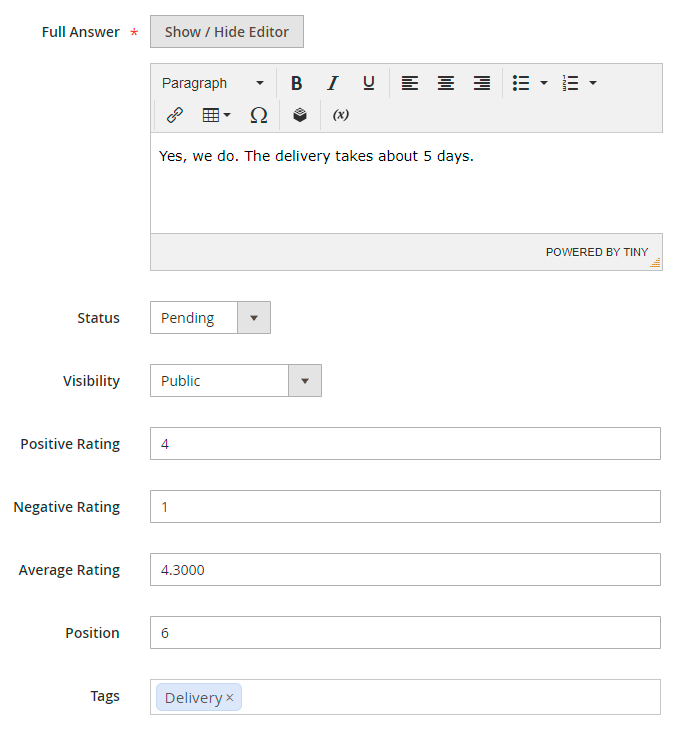
Full Answer — fill in the full answer using the WYSIWYG editor This field is mandatory due to answer display logic;
Status — choose the question's status: pending or approved;
All incoming questions automatically get the Pending status. When an admin answers the question, the status should be manually switched to Answered. This functionality is used to easily monitor the unanswered questions.
Visibility — define the question's visibility:
- None
- Public
- For logged in only
Positive Rating — when the rating functionality is enabled, you can force a custom number of positive votes;
Negative Rating — when the rating functionality is enabled, you can force a custom number of negative votes;
Average Rating - when the Average Rating type is enabled, you can set a custom number;
Position — set the position of the question in the list. The lower the value the higher the answer will be displayed.
Tags — specify tags that reflect the question's essence (you can use more than one tag for a question). This will help your customers to better navigate your website and easily find the relevant information.
This is how tags display on the frontend:


Please note, that you can fill in only the full answer. It will be shortened automatically using the Limit display answer length (set it here) value to display the answer preview.
SEO
Meta Title — specify the meta title for the question;
When the Meta title field is empty, than the Question field will be used.
Meta Description — fill in the meta description for the question;
Exclude from XML Sitemap — enable the option to exclude this particular question from the XML sitemap;
Noindex — enable to prevent this question page from being indexed;
Nofollow — enable to prevent this question page from sharing its weight with the links on it;
Canonical — specify the canonical URL for the question.
The Canonical URL option should be enabled in the SEO section.
To improve the SEO rankings, all your knowledge base can be included in the web-store XML site map. Get it easily done with the Amasty Google XML Sitemap extension, which is fully compatible with this module.
Customer Info
When a customer submits a question, this section is filled in automatically. However, the admin user can edit customer information if needed. When creating a new question from the admin panel, these fields can be left empty.
Sender Name — the question sender name;
Sender Email — the question sender email.
Categories
Use the Asked In option to assign the question to multiple categories. This will be used to display a question in different categories in the knowledge base. You can leave a question unassigned and it will be visible from the corresponding product pages and via direct URL only.
Products
Click the Add Products button to assign the question to products. This particular question will be displayed in the Product Questions tab on the selected product pages.
Please, note that the XX selected value reflects the total number of the assigned products.
You can use the Filters buttons to search for required products using various criteria.
When everything is set, hit the Save button to return to the questions grid or use the Save and Send Email to Customer button to send the notification to the question author.
Please note, that the Customer Info section should be filled in order to have the ability to send the email notifications.
Categories
To add new categories to your knowledge base or edit the existing ones, please go to Content → Categories.
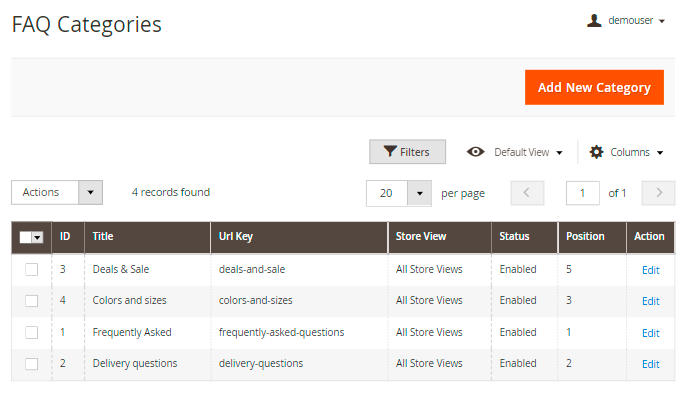
On the grid you can modify categories using the Inline edit functionality. Click on the value you need to modify to edit it. Moreover, you can select multiple categories and apply the required mass actions (edit, delete, change status).
Using the Position column you can adjust the categories sort order on the FAQ page.
Hit the Add New Category button or select the existing category to edit it.

Enable Category — enable or disable the category on the front-end. This option doesn't affect the categories grid;
Category Name — fill in the category name to display on the front-end;
Category Name on Category Page - fill in the field if you want to display a different category name on the category page on front end. You can use this feature in SEO purposes. Otherwise, the name specified in the ‘Category Name’ setting will be used.
See how it works:
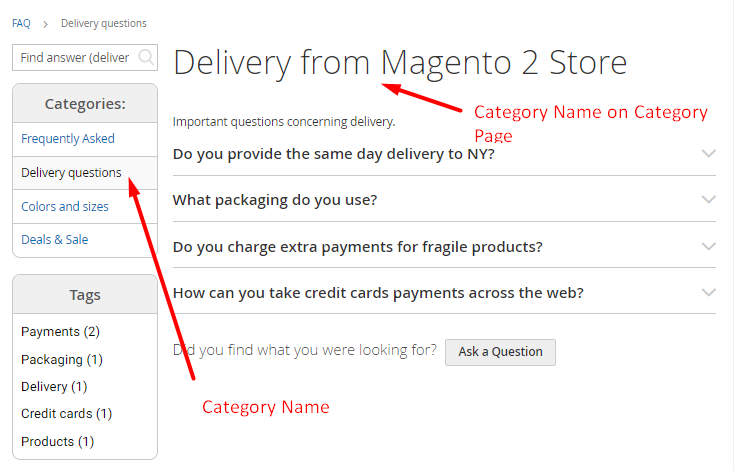
URL key — modify the category URL that is generated based on the Category Name field;
Store View — define store views where the category will be displayed;
Display for Specific Customer Groups - choose customers groups for which the category will be visible.
Position — set the position of the category in the list. The lower the value the higher the category will be displayed;
Icon — add the unique icon for a category (JPG, PNG, or GIF; up to 2MB);
Description — fill in the description of a category.
Assigning Questions to Categories
To assign questions to the category, please expand the Questions section and hit the Add Questions button.
When everything is set, please click the Save button to return to the categories grid.
SEO for Categories
To configure SEO settings for a particular category, expand the corresponding section.
Meta title — specify the meta title for the category;
Meta description — fill in the meta description for the category;
Exclude from XML Sitemap — enable this option to exclude this category from the XML sitemap;
Noindex — enable this option to prevent the category from being indexed;
Nofollow — enable this option to exclude the links from this category from being followed by search engines;
Canonical — specify the canonical URL for the category.
The Canonical URL setting in the SEO section should be enabled.
FAQ Search Terms Report
To see the report on FAQ search queries, please, go to Content → FAQ Search Terms Report.
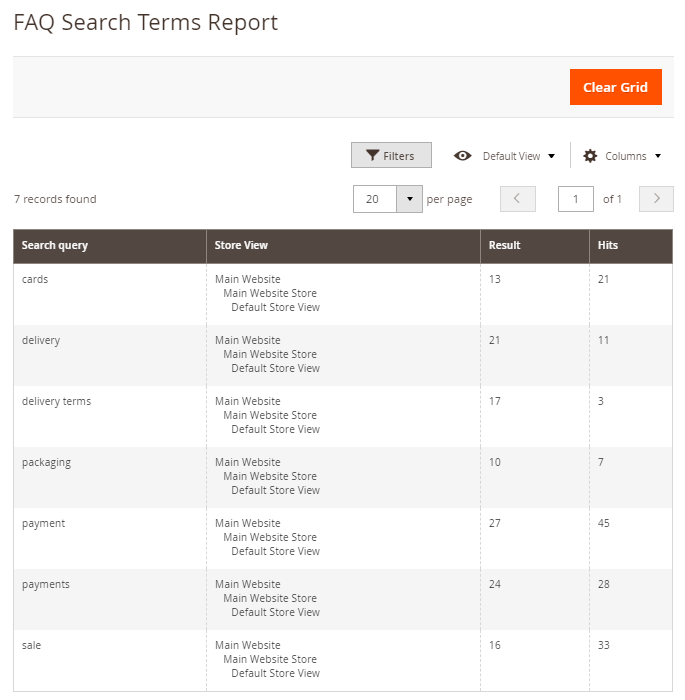
Here, you can keep records and analyze search queries to make your FAQ section more effective. The report shows you search queries themselves, the number of displayed search results and the number of hits.
With the data gained, you can reach your site visitors with more relevant and useful information and thus transform them into regular customers.
FAQ Widgets Implementation
The module comes equipped with the default FAQ Home Page CMS-page. This CMS-page consists of three widgets that can be modified and used separately on any other CMS-page. They are:
- FAQ Questions List
- Back to Product Button
- FAQ Categories List
- FAQ Search Box
Each of the widgets has individual settings. To insert a widget, please, go to Content → Pages and select the required CMS-page. Then, enable the WYSIWYG editor and click the Insert Widget button.
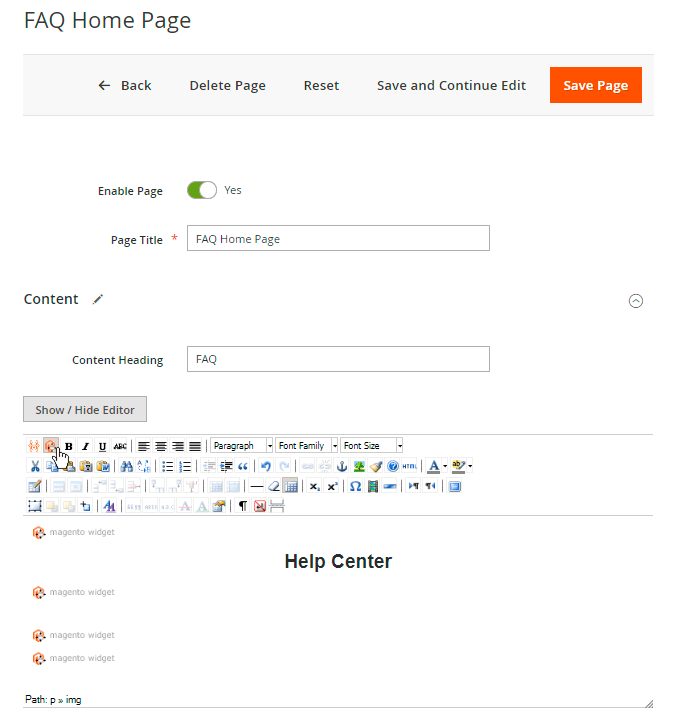
Next, select the required widget from the dropdown menu. These are the available settings for the FAQ widgets:
FAQ Questions List
The widget is used to display a list of product questions. It can be a list of specified questions as well as questions related to a product, current product, or FAQ category. In order to configure this widget, please follow the instructions below:
1. Navigate to Content → Widgets → click the button 'Add Widget';
2. Select 'Amasty FAQ Questions List' from the first dropdown, then select a design theme, and click 'Continue';
3. Now we're configuring 'Storefront properties'. Here you can specify widget title, store views, and the sort order of widget instances.
4. Now proceed with the 'Widget Options'. Here you can specify the block title and select from four widget types:
- FAQ Category - to display on the widget questions taken from the specific FAQ Category;
- Specific Questions - to display on the widget some specific questions;
- From Specific Product - to display on the widget questions taken from the specific product;
- From Current Product - to display on the widget questions taken from the current product you're configuring this widget for.
After choosing the widget type you can also:
- Specify whether to 'Show short answer' or 'Show cut full answer' in the 'Show answer behavior' setting;
- Set up a limit for the 'Displayed Answer Length' (mandatory field);
- Choose whether to 'Show Ask a Question Button'.
Back to Product Button
This button is used to return to the previously viewed product.
Back To Product button Align — define the alignment of the Back to Product button.
FAQ Categories List
The widget is used to display a block of categories adjusted with the following settings:
Layout Type — define the number of columns where the categories will be distributed;
Limit question number in category — set the maximal number of questions to display in each category;
Limit categories number — limit the number of categories to use in the block (categories will be chosen by their priority);
Categories list without questions — choose Yes to display the categories list only;
Sort Categories By — define the sorting behavior for categories;
Sort Questions By — define the sorting behavior for questions;
Short Answer Behavior — choose how to display the answer preview: a short answer or a cut full answer.
FAQ Search Box
The widget adds a separate search box to the content in the knowledge base.
Search Box Width — specify the search box width on the page using CSS-length values (e.g. 00px, 77pt, 20em, .5ex, or 50%);
Search Box Align — define the alignment of the search box inside the CMS-page.
When all widgets are set and configured, hit the Save button to save the CMS-page.
FAQ Page Layout

By default, the extension uses the layout based on the pre-configured CMS-page that includes all three widgets and provides FAQ visitors with the search bar, the 'Back to Product' button and a list of categories. The first category is determined using the categories sort order values.
When you add tags to the questions, the list of tags will appear under the list of categories:

Using the extension settings, you can return the FAQ page to its basic view with the list of categories and the content of the highest category.
The number of questions to display is not limited. The Back to Product button returns customers to the last viewed product.
Email Templates
To configure the email templates for Admin/Customer notifications, please go to Marketing → Email Templates.
Hit the Add New Template button or edit the existing ones according to your needs.
In the Load default template section you can load one of the built-in Magento 2 email templates.
To create a new template, configure the following options:
Template Name — specify the template name for internal use;
Template Subject — fill in the template subject for emails;
Template Content — fill in the content of the email template;
Template Styles — optionally, you can specify custom template styles.
Hit the Save Template button when everything is done. Now, you can use the created template for the admin or customer notifications.
Email Sender
The email sender can be changed at Stores → Configuration → General → Store Email Addresses. Please modify the required contact according to your needs.
Questions and Categories Import
With the extension, you can easily import questions and categories to fill your knowledge base with data. Hence, you can quickly transfer the FAQ and Product Questions extension for your Magento 1 store.
When you exported questions and categories you will have the two separate files.
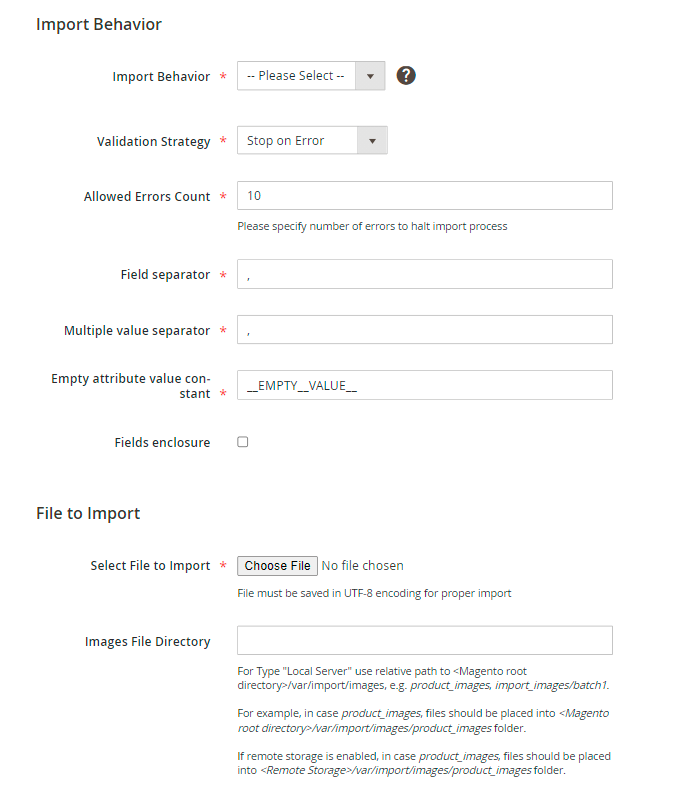
Please, go to System → Import FAQ Categories or System → Import FAQ Question (or System → Import and choose the Entity Type: Amasty FAQ Categories or Amasty FAQ Questions). Then, choose the import behavior:
- Add (add information to the existing FAQ database. During the import the existing IDs will be ignored and the new notes will be added);
- Add/Update (add information with new IDs to the existing FAQ database or update the ones with the same ID);
- Delete (delete information from the database for notes with the identical IDs).
Then, choose Validation Strategy and in the Select File to Import option choose the file with the categories you need to import and hit the Check Data button.
The file for categories import should contain the following:
- category_id
- title
- url_key
- store_codes — valid store codes required for file validation
- status
- meta_title
- meta_description
- position
- question_ids — correct values required to assign questions to categories
The file for questions import should contain the following:
- question_id
- question
- url_key
- store_codes — valid store codes required for file validation
- short_answer
- answer
- is_show_full_answer — 0 for displaying a short answer with a 'Read More' link and 1 for displaying the full answer (or its part if too large)
- status — 0 for pending and 1 for answered
- visibility — 0 for none, 1 for public, and 2 for logged in only
- position
- meta_title
- meta_description
- name
- email
- category_ids — correct values required to assign questions to categories
- product_skus — correct values required to assign questions to products
For both cases you can download the Sample files below and unarchive them to learn more about the import structure and adjust your own CSV files:
Export
The extension supports questions and categories export using the default Magento functionality. Please, go to System → Export. Choose Amasty FAQ Categories or Amasty FAQ Questions from the Entity Type dropdown menu.
Then, in the Entity Attributes section, you can exclude certain fields from the resulting export file.
When done, hit the Continue button.
The extension if compatible with Amasty Magento 2 Cross Linking extension
Google Invisible reCaptcha
Google invisible reCaptcha in included in the FAQ package. It protects your store from spam and fraud while letting real customers pass through easily. But anyway Captcha integration takes time and coding effort. To minimize your developer's work, we created an Invisible Captcha solution. Now it's enough just to fill some settings fields to secure your store.
- Manage your captcha settings in one place
- Make changes without digging into a website code
- Protect your store with the latest security option
Check how to configure it properly in this guide.
Find out how to install the FAQ & Product Questions extension via Composer.
magento_2/faq_and_product_questions.txt · Last modified: 2025/07/28 09:16 by kkondrateva






